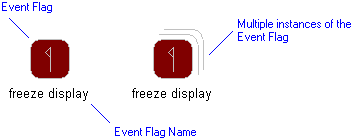Event flag (dictionary item)

For automation interface information about an Event Flag, click here Event flag (automation interface).
An Event Flag indicates that a given event has happened. It is used when tasks need to communicate but not necessarily synchronize. The standard operations associated with an event flag group are:
• Set
• Clear
• Read
You can create an Event Flag through the context menu of a Package: right-click the Package, and select > > > . In addition, you can create an Event Flag through a Concurrency Diagram.
When used on a diagram, an Event Flag's notation is as follows:

In the Modeler panes, a short-cut symbol  on the Event Flag's icon indicates that the item is a stub.
on the Event Flag's icon indicates that the item is a stub.
 on the Event Flag's icon indicates that the item is a stub.
on the Event Flag's icon indicates that the item is a stub.The following sections provide information about how an Event Flag is used in the model. For more information about a property, item, model part or diagram, click it.
Properties
In addition to the standard properties, an Event Flag has these properties:
The Class box on the Options tab of a Event Flag's Property Pages shows the Class, Data Type or Interface that owns the Operations that implement the Event Flag. |
Owned by
Owns
 Dependency — The Dependency is owned jointly by the Event Flag and the other associated item. The access permissions you have to a Dependency are determined by the access permissions of the dependent item.
Dependency — The Dependency is owned jointly by the Event Flag and the other associated item. The access permissions you have to a Dependency are determined by the access permissions of the dependent item.Defined in these parts of the model
Shown on these diagrams
Can be linked to these dictionary items
 Class — The linked Class contains the Operations required to implement the Event Flag (drag Class to Event Flag symbol on diagram).
Class — The linked Class contains the Operations required to implement the Event Flag (drag Class to Event Flag symbol on diagram). Data Type — The linked Data Type contains the Operations required to implement the Event Flag (drag Data Type to Event Flag symbol on diagram).
Data Type — The linked Data Type contains the Operations required to implement the Event Flag (drag Data Type to Event Flag symbol on diagram). Interface — The linked Interface contains the Operations required to implement the Event Flag (drag Interface to Event Flag symbol on diagram).
Interface — The linked Interface contains the Operations required to implement the Event Flag (drag Interface to Event Flag symbol on diagram).Like most other items in a Model, an Event Flag can be linked to an Activity Partition, Comment, Frame Box, General Node, General Flow, General Flow Diagram Node, Constraint (applied), General Flow Diagram Flow or Swimlane. |
 Model
Model Package
Package Comment
Comment Constraint
Constraint Concurrency Model
Concurrency Model Concurrency Diagram
Concurrency Diagram Variant Diagram
Variant Diagram Stereotype
Stereotype